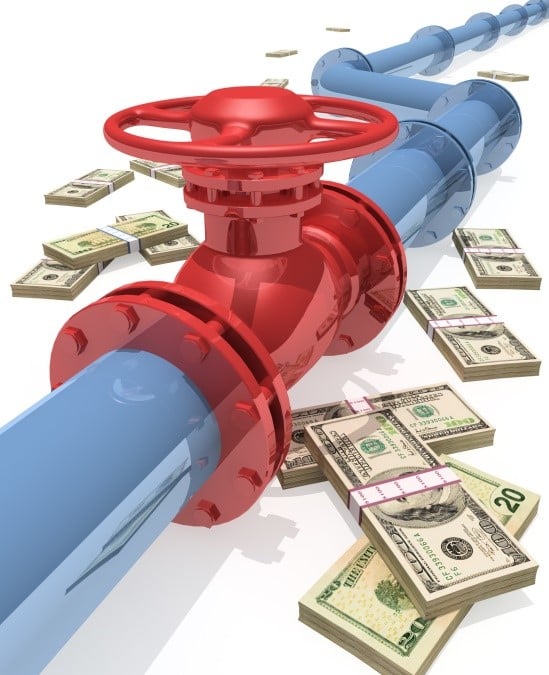
Before starting Fusion Marketing Partners in 2009, I talked to a number of B2B consultants that I respected to get their feedback on my proposed services model. Several told me about a cycle where they would work extraordinary hours for a period (weeks or months); then find themselves with little to do other than hunt for new business.
This is a familiar business cycle (especially in consulting companies):
- Find some new business.
- Service the new clients/customers.
- Experience a dip.
- Find new replacement business.
This can be a frustrating experience, sort of the business equivalent of a roller coaster ride. At one point you are on top of the world with plenty of business and flush cash-flow. In the next period you are at the bottom of the trough, scrambling to find new revenue streams. Exciting to be sure, but also painful!
Like this:

I did not like the sound of this and resolved to use my expertise to create a saner and more effective model. After all, how could I ask client companies to invest in our team if I couldn’t find a good way to market us?
Lessons Learned
Here is what we did and what you can do, assuming this type of model works for you. Remember that while this is written from a professional services company perspective, much of it can apply to product companies.
- Work on your business, not just in your business.
You’ve probably heard this statement a number of times but how to apply the principle? Basically, it means that you don’t make the “important” the enemy of the “urgent”. In our case, this meant that we (FMP) would always treat ourselves as well as we treat clients. The excuse “we are too busy with client work” is not considered a valid excuse for not focusing on our own market outreach initiatives. - Be relentless. By this I mean that you should establish a content creation and content propagation schedule and stick to it. If your intention is to blog 3-4 times per month and share each post a certain number of times, then do so. Social media and pull marketing is not a panacea to instantly solve all your marketing problems. But it can have quite a nice cumulative impact as you build your brand reputation.
- Be consistent. This means that you need to pick your spots. Better to be a niche content producer and go deep into a particular subject of interest, than feed your readers with your latest stream of consciousness. I know that there are exceptions, but generally, specialists beat generalists at the content marketing game.
- Produce quality marketing content. By quality, I mean that readers will find your stuff both interesting and relevant. If you do this, they will subscribe and/or come back for more. Most important, they will contact you – you will not have to chase them – at the time they are ready to engage. Isn’t this a much better, saner, pleasant and effective way to achieve sales than traditional push marketing methods?
- Make your website a magnet. By magnet, I mean that your website is an irresistible attraction to those interested in learning more about your areas of expertise, regardless of where they are in their own buyers’ journey. And whether the sales cycle takes ten minutes or ten months, every successful engagement goes through four stages: awareness, education, engagement and sale. Your website needs to optimize each of these steps. To make sure it does so, visit the websites of your three largest competitors and do what you need to do to beat each of them at all four stages.
- Have a conversion plan. All the preceding steps will not do you much good unless you do a good job of converting the inbound/pull leads into sales opportunities – and, of course, sell them something. We call this the lead-to-revenue process and it can be highly variable based on your products/services, offers, channels and so forth. To learn more, download the free eBook titled The Essential Guide to Building Your Lead-to-Revenue (L2R) Machine.

The pull marketing model smooths out revenue dips
We have used this model to attract new clients from the U.S., Germany, India and Italy (the latter two of whom we have never met in person). These clients came to us because they found our blogs, white papers, videos or audios online. Because the inbound lead flow is steady, we can be selective and work only with companies where the fit is good (for the client and for us).
By the way, the new vs. old sales pipeline model also applies in non-revenue scenarios. For example, I’ve had many variations of this conversation over the years: “Hi Chris, how is the business, how is the family? I know we haven’t talked in a few years (e.g. ten) but I was thinking about you and thought I would re-connect.” So far, so good, right? However, within two minutes, my long lost friend tells me they are looking for a job; wants a reference or referral; or have some other request. I usually help anyway, but if this individual had kept in touch over the years, I would be more receptive. The point is that you (and I) need to build and nurture your network before you need them, not after.
A full sales pipeline is the lifeblood of a healthy organization. Follow the above strategies and everyone in your company’s revenue chain will sleep better at night.



